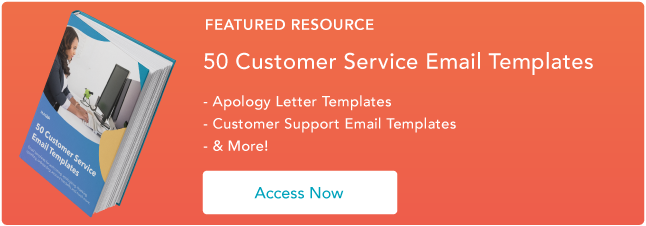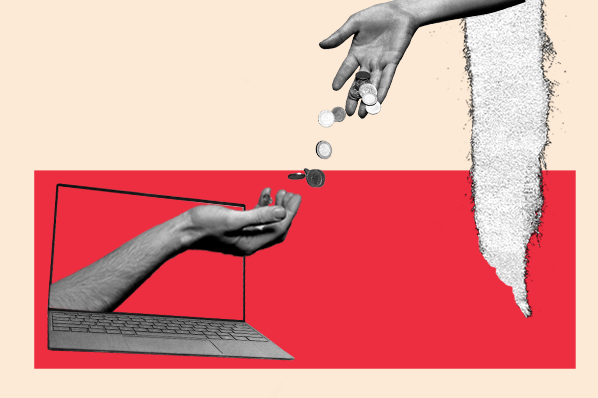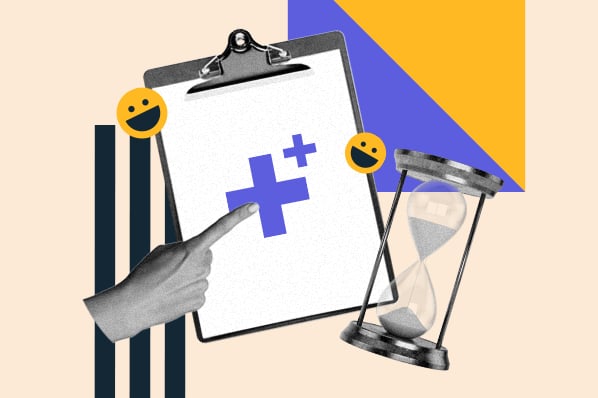Think your email skills are strong? Think again. As it turns out, we all overestimate our ability to communicate effectively over email.

In a study published in the Journal Of Personality And Social Psychology, email writers thought readers would correctly identify the tone of their emails about 78% of the time. In reality? Only 56% of emails were interpreted accurately.
That means when you send an email off to a customer, there's a pretty good chance they won't fully grasp your intended meaning.
So how can you proofread your emails to avoid problematic misunderstandings with your customers? Start by cutting the fat.
The following commonly used phrases are unnecessary, cliché, and easy to misinterpret. Eliminate them from your email repertoire to take your customer communication skills to the next level.
Email Phrases to Avoid
- "Sorry to bother you"
- "Let's touch base"
- "To be honest with you ... "
- "You should ... "
- "No problem"
- "I'll try ... "
- "The problem is ... "
- "I completely understand how you feel"
- "As I mentioned before ... "
- "Checking in"
1. "Sorry to bother you"
You might say this when you want to sound polite and considerate of your customer's busy schedule, but opening an email with an apology immediately undermines your credibility.
Instead of apologizing, get straight to the point: Why are you really contacting your customer, and what do you need from them? They'll appreciate your candor.
2. "Let's touch base"
This phrase has the not-so-honorable distinction of being one of the most overused corporate phrases ever, and unless you're literally talking about landing a helicopter, there's no need to use it in your client emails.
The biggest issue with asking a customer to "touch base" is that it's too vague. It's a filler phrase that doesn't explain what you want to discuss, leaving them completely in the dark.
Swap it out for something actionable that lets the customer know what their next steps should be, e.g., "Let's chat on Friday to make sure you're well-versed in the new website navigation."
3. "To be honest with you ... "
This one is tricky. It's commonly used to add emphasis to a candid remark or soften the blow of a blunt comment ("To be honest with you, you don't update your blog frequently enough"), but it could have the exact opposite effect, leaving your customer wondering, "Wait ... were you not being honest with me before?"
This seemingly innocuous phrase can make it seem like you've been hiding your true opinions this whole time, which obviously isn't great for building trust. The customer is relying on you for your expertise, so they expect you to share your true opinions openly and honestly, not just in select situations.
Cut this phrase from your emails and instead focus on telling it like it is -- without any crutch phrases.
4. "You should ... "
When your customer is insistent that pink Comic Sans font is the way to go, it can be challenging to refrain from typing back, "You should really just use X font instead."
Your customer doesn't need you to make all of their decisions for them. While starting a sentence with "you should" might sound fine in person, it could easily be misinterpreted as pushy or dismissive over email.
Use "I recommend ... " instead -- it will make sure your remarks are read as friendly advice. Offer alternatives, not ultimatums.
5. "No problem"
Customer service experts and business writers agree: "No problem" can be a big problem. This ostensibly polite phrase is usually a knee-jerk reaction to "Thank you," but it can subtly communicate to your customer that whenever you do something for them, it actually is a problem. "No problem" sounds like you're forgiving your customer for an offense, rather than accepting their thanks.
Are we overthinking this? Maybe. Should you still cut it from your emails? Definitely. It's easy enough to replace with a "You're welcome," or "Sure thing," rather than risk the miscommunication.
6. "I'll try ... "
In a world ruled by deadlines and calendar invites, "I'll try" sounds wishy-washy. If you respond to a customer's request with "I'll try to get that done by Wednesday," or "I'll try to solve that problem with the product team," you aren't exactly instilling confidence in your ability to advocate for them and their challenges.
When communicating over email without the aid of body language and tone, it's important to convey information in precise, detailed terms. Even if you're legitimately unsure about when, or if, you'll be able to get something done, provide the customer with a real deadline -- just push it out far enough to give yourself adequate time.
7. "The problem is ... "
Instead of framing a problem as well, a problem, try to explain it is a specific challenge with a known solution. The additional information will help assure the customer that you know exactly what's wrong, and more importantly, how to fix it.
"The problem is we're experiencing a system-wide outage," sounds alarming and vague, but "We're working on fixing an isolated outage that will have you back up-and-running by the end of the day" sounds like you have a handle on what's happening.
8. "I completely understand how you feel"
Before you write this in an email, stop and think: Have you ever been in this exact situation before? No? Then don't write this phrase. It will only frustrate an already-frustrated customer.
"I understand how you feel" might seem like a thoughtful, well-intentioned thing to write to a customer experiencing obstacles using your product or service, but it can come across as distanced and condescending in an email.
There's almost always a better, more specific way to level with a customer when things aren't going as planned. Try: "I can definitely see how this is frustrating for you, and I want to make sure we're addressing it ASAP." Action-oriented language will console a customer more than vague apologies.
9. "As I mentioned before ... "
Even though it might seem like you're always explaining the same things over and over again to your customers, it's important to avoid this morale-killing phrase. The average person receives 122 emails per day, so you'll have to forgive them if they occasionally skim through or miss some of your communications.
Instead of drawing attention to the fact that you're repeating yourself (as satisfying as that might seem) try to be considerate of the fact that -- like you -- your customer is busy, and sometimes details slip through the cracks. If a customer is consistently missing the point, it's probably time for a call. Not everything can be solved over email.
10. "Checking in"
Nothing brings a recipient more trepidation than seeing a "Checking in" subject line in their inbox. If you have something specific in mind you want to review with your customer, indicate that in the subject line so they're prepared to respond -- and not freaked out or confused.
Now that we've covered the phrases you should avoid, let's dive into the ones you should start using instead.
Business Email Phrases to Try
- Thanks for...
- Please feel welcomed...
- I hope all is well.
- I would appreciate your help.
- Looking forward to hearing from you.
- My apologies for…
- I understand 'x' has caused 'y'...
- I wanted to update you…
- I’d be happy to…
- ...you...
1. "Thanks for…"
One lesson that I learned in customer service was the power of avoiding unnecessary apologies. Whenever you apologize, you're admitting that you or your company made a mistake. Sometimes this is necessary, but keep in mind that this admission takes a toll on the customer's experience. Some customers might not realize you've made a mistake until you highlight it.
Instead, try thanking customers rather than apologizing to them whenever a minor inconvenience occurs. Say phrases like, "Thanks for your patience." and, "Thank you for your understanding." These messages compliment the customer while still acknowledging the roadblock.
2. "Please feel welcomed…"
Whenever you're providing a customer with information, you should give them a way to contact you in case they have questions. But, saying things like, "Let me know if you have any questions," may come across as authoritative and dissuade customers from following up.
The phrase, "Please feel welcomed…" invites customers to reach out whenever they feel comfortable. This creates an open door where users can ask questions at any point in the customer's journey. Even if they don't have questions right away, this phrase lets them know they can touch base with you if they need to clarify details in your original message.
3. "I hope all is well."
When starting your email, you should include a message like this to begin a friendly dialogue. This shows that you value the interaction and creates a personalized relationship with the customer.
If you jump straight into problem-solving, the customer may feel like they're just another case you need to work on. Checking in on their well-being before troubleshooting shows that you're emotionally intelligent and invested in their experience.
4. "I would appreciate your help."
Sometimes you're going to have to ask a customer for help, but this can be easier said than done depending on the favor you're asking from them.
When seeking help from a customer, describe what you need, first. Then, summarize exactly how they can help you accomplish your task. Make sure you align your goals with the customers' to ensure they understand what you're asking them to do. Finally, wrap up your request by saying you would greatly appreciate their help in the matter.
5. "Looking forward to hearing from you."
This is a great phrase to use when wrapping up your emails. Rather than saying, "Talk to you soon," or, "Thanks again," this keeps the dialogue open and sets up an expectation for a response. If you're asking a customer for help or additional information, this is an effective message for encouraging feedback.
6. "My apologies for…"
While you'll want to limit your apologies, there are going to be times where you make mistakes and need to take accountability for your actions. In these instances, you should use the phrase, "my apologies," instead of "I'm sorry," for two major reasons.
First, "my apologies" sounds much more professional than, "I'm sorry." This is particularly important for B2B service reps who work with customers that expect a certain level of professionalism.
Second, "my apologies" appears more genuine to customers. Since "I'm sorry," is a casual phrase, customers may think you're just using it as an easy out. But, using the phrase, "my apologies for..." shows that you've put some thought into your response and are aware of the inconvenience you've caused.
7. "I understand that ‘x' has caused ‘y'..."
In some cases, you'll need to apologize for something that you didn't directly cause. Maybe it was a faulty product or that the customer was given poor advice from a previous rep. Whichever the cause may be, it's important to know how to respond to roadblocks that you have no control over. This phrase shows that you understand how and why a problem happened, and what effect that issue had on your customer.
In customer service, most friction occurs when customers feel like the rep doesn't understand their problem. So, by demonstrating an in-depth understanding of the issue, it becomes much easier for reps to align with customers during the interaction. Customers will trust that you're working to resolve their issue because they know you fully comprehend the case.
8. "I wanted to update you…"
When troubleshooting doesn't go as expected, you can use this phrase to provide additional information to your customers. Rather than saying there was an issue or a setback, having an update implies that you're continuing to make progress on their case.
Even if the update is a roadblock you'll need to overcome, using this language makes the problem feel more surmountable. This will help maintain trust with a customer even when a problem is more complicated than expected.
9. "I'd be happy to…"
If you offer to do something for a customer, then you should sound excited to do it. After all, you're there to create a delightful experience for the user, so any assistance they need should be your number one priority. With that in mind, this phrase shows customers that you're eager to help out and that there's nothing too difficult or tedious that you can't do for them.
10. "...you…"
In my third year of college, my Translyvannian marketing professor gave me the best advice when writing emails. She told me that I should look for every opportunity to include the word "you." This would make whatever I was asking automatically more persuasive to the reader.
The reason being is that when you include the word "you," you're calling out the reader. You're talking to them specifically and making a direct request. It's much harder to ignore a call for help when the person in need makes it sound like you're the best person for the job. By incorporating the word "you," your readers will feel like if they don't help, no one else will.
To learn more, read our list of customer service email templates next.
![→ Access Now: 50 Customer Service Email Templates [Free Resource]](https://no-cache.hubspot.com/cta/default/53/9a8328ad-9a07-4f92-aa9c-468dc3a4a9d7.png)






![Big Brands That Lost Customers' Satisfaction in 2023 [Where CX Went Wrong + Data]](https://www.hubspot.com/hubfs/companies%20that%20lost%20customers_featured.png)



![How to Calculate Churn Rate in 5 Easy Steps [Definition + Formula]](https://knowledge.hubspot.com/hubfs/ai%20customer%20service%20predictions%20%283%29.webp)